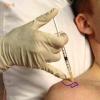CYBERMED LIFE - ORGANIC & NATURAL LIVING
CYBERMED LIFE - ORGANIC & NATURAL LIVING
 Acupoint Injection Therapy (AIT) is the injection of herbs, vitamins, and mild analgesic into acupuncture points to help with pain management, general health, palliative care, and to help prevent disease. It’s not a substitute for traditional needle acupuncture, but rather an additional treatment that may be beneficial to the patient.
Acupoint Injection Therapy (AIT) is the injection of herbs, vitamins, and mild analgesic into acupuncture points to help with pain management, general health, palliative care, and to help prevent disease. It’s not a substitute for traditional needle acupuncture, but rather an additional treatment that may be beneficial to the patient.
How does AIT work?
Acupoint Injection Therapy (AIT) activates acupuncture points much in the same way as the insertion of dry needles (IMS - Intramuscular Stimulation), but with additional healing provided by the remedies that are used during the injection. AIT is associated with minimal discomfort and less post-injection soreness. Many patients will notice a positive response to their pain levels shortly after treatment.
What Conditions Can Be Treated with Acupoint Injection Therapy?
Some of the more common conditions treated with Acupoint Injection Therapy include:
How Many Treatments Will Be Required?
Most patients will notice a change immediately following your Acupoint Injection Therapy. However, most conditions will require multiple treatment sessions in order to achieve the desired optimum healing result. When the natural therapeutic injectables are introduced into the affected area, the body easily absorbs the substance and answers with a quick immune response. By applying the injectables directly on acupuncture points, the power of both the acupuncture point and the biotherapeutic medicine are greatly enhanced. Furthermore leaving a deposit of medicine in the injection side will activate and stimulate the acupuncture point for a longer period of time, enhancing the therapeutic effect. Therefore, AIT can help to speed up healing and restore health.